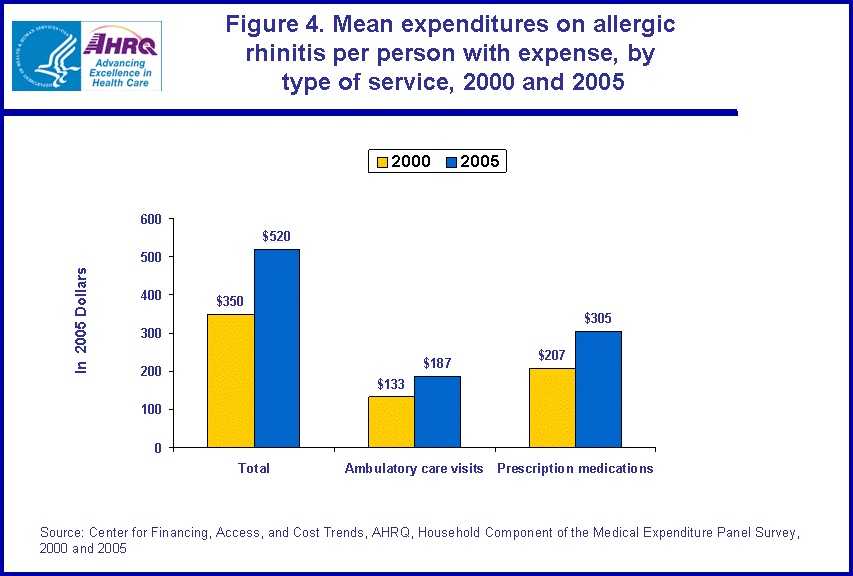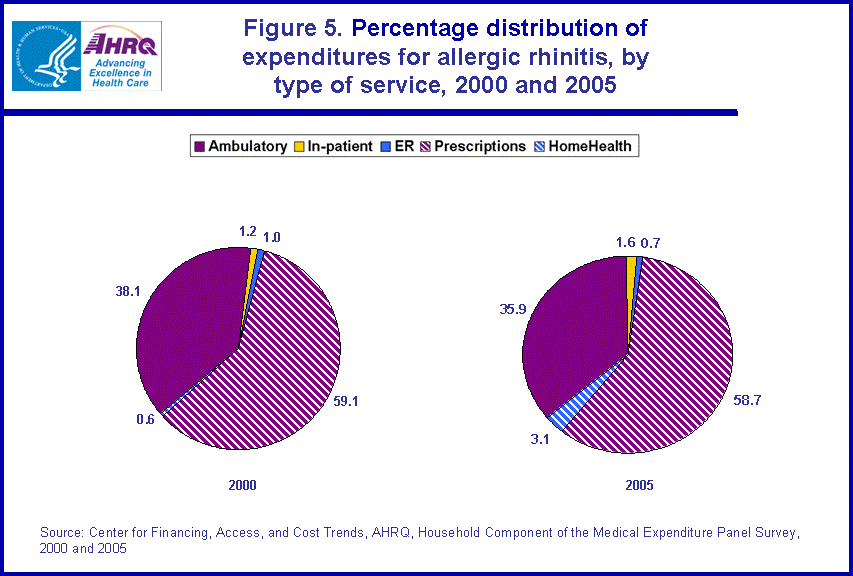
|
|
Font Size:
|
||||
|
|
|
|
||||
STATISTICAL BRIEF #204:
Allergic Rhinitis: Trends in Use and Expenditures, 2000 and 2005
Highlights
- In 2005, approximately 22 million persons or 7.3 percent of the U.S. population reported experiencing related symptoms, visiting a physician, or obtaining a prescription drug to treat allergic rhinitis.
- Medical spending to treat allergic rhinitis almost doubled from $6.1 billion in 2000 (in 2005 dollars) to $11.2 billion in 2005.
- Ambulatory expenditures for care and treatment of allergic rhinitis increased 73 percent from 2000 to 2005.
- Mean annual expenditures for those with an expense related to allergic rhinitis increased from $350 per person in 2000 (in 2005 dollars) to $520 per person in 2005.
- In 2000 and 2005, more than half of the total allergic rhinitis expenses were spent on prescription medications.
Introduction
Allergic rhinitis is a collection of symptoms such as coughing, sneezing, watery eyes, itching in eyes and nose, headache, and wheezing in people allergic to airborne particles of dust, dander, or plant pollens. When these symptoms are caused by pollen, the allergic rhinitis is commonly called hay fever.
This Statistical Brief presents estimates based on the Household Component of the Medical Expenditure Panel Survey (MEPS-HC) on the use of and expenditures for ambulatory care and prescribed medications to treat allergic rhinitis among the U.S. civilian noninstitutionalized population. Average annual estimates (in 2005 dollars) for the years 2000 and 2005 are shown by type of service and source of payment. All differences between estimates noted in the text are statistically significant at the 0.05 level or better.
Findings
Number of reported cases for allergic rhinitis, by sex
In 2005, 7.3 percent of the U.S. population or 22 million persons reported experiencing related symptoms, visiting a physician, or obtaining a prescription drug to treat allergic rhinitis (figure 1). In 2000, the same was reported by 6.3 percent of the population. In both 2000 and 2005, more females reported experiencing allergic rhinitis than males (7.6 percent versus 4.9 percent in 2000 and 8.2 percent versus 6.4 percent in 2005).
Total and average reported mean health care expenditures on allergic rhinitis, by age
A total of $6.1 billion (in 2005 dollars) was spent on health care and treatment of allergic rhinitis in 2000 (excluding over-the-counter medications). By 2005, total expenditures to treat allergic rhinitis almost doubled to $11.2 billion (figure 2). Average expenditures per person for those with an allergic rhinitis related expense increased from $253 to $434 for those under age 18, from 2000 to 2005, and for those ages 18-64 from $381 to $566 (figure 3).
Total and average mean health care expenditures on allergic rhinitis, by type of service
There was a 73 percent increase in the ambulatory expenditures on allergic rhinitis from 2000 to 2005. In 2000, a total of $2.3 billion (in 2005 dollars) was spent on ambulatory visits related to allergic rhinitis compared to $4.0 billion in 2005.
Among those who received treatment for allergic rhinitis, $350 (in 2005 dollars), on average, was spent for treatment in 2000 (figure 4). In 2005, per person expenditures increased to $520. An average of $207 was spent per person on prescription medicines for allergic rhinitis in 2000, as compared to an average of $305 in 2005.
Distribution of average annual health care expenditures for allergic rhinitis, by type of service
For the treatment of allergic rhinitis in both 2000 and 2005, more than half (59.1 percent and 58.7 percent, respectively) of the total was spent on prescription medications and more than one-third was spent on ambulatory visits (38.1 percent and 35.9 percent, respectively) (figure 5).
Data Source
The estimates shown in this Statistical Brief are based on data from the MEPS 2000, and 2005 Full Year Consolidated Files (HC-050 and HC-097), Medical Condition Files (HC-052 and HC-096), Office-Based Medical Provider Visit Files (HC-051G and HC-94G), Outpatient Department Visits Files (HC-051F and HC-094F), Hospital In-Patient Stays Files (HC-051D and HC-094D), Home Health Files (HC-051H and 094H), Emergency Room Visit Files (HC-051E and HC-094E), and Prescribed Medicine Files (HC-051A and HC-094A).
Definitions
Allergic rhinitis
This brief analyzes individuals with allergic rhinitis reported as a condition bothering the person and allergic rhinitis reported in connection with reported health care utilization (e.g., a person who reported purchasing a drug was asked what condition the drug was intended to treat) or reported disability days. The conditions reported by the respondent were recorded by the interviewer as verbatim text, which was then coded by professional coders to fully specified ICD-9-CM codes. Conditions with an ICD-9 code of 477 were classified as allergic rhinitis.
Expenditures
Expenditures in MEPS are defined as payments from all sources for hospital inpatient care, ambulatory care provided in offices and hospital outpatient departments, care provided in emergency departments, as well as prescribed medicine purchases reported by respondents in the MEPS-HC. Sources include direct payments from individuals, private insurance, Medicare, Medicaid, Workers' Compensation, and miscellaneous other sources. Expenditure data for 2000 was adjusted to 2005 dollars using the Personal Health Care Expenditure Price Index (Centers for Medicare and Medicaid Services, Office of the Actuary).
These expenditures do not include 'over-the-counter' medications used for treatment of allergic rhinitis. (Many popular prescription medications such as Zyrtec and Claritin used for treatment of allergic rhinitis are currently sold as 'over-the-counter', were sold as prescription drugs only in years 2000 and 2005, thus are included in the expenditures).
About MEPS-HC
MEPS-HC is a nationally representative longitudinal survey that collects detailed information on health care utilization and expenditures, health insurance, and health status, as well as a wide variety of social, demographic, and economic characteristics for the civilian noninstitutionalized population. It is cosponsored by the Agency for Healthcare Research and Quality and the National Center for Health Statistics.
For more information about MEPS, call the MEPS information coordinator at AHRQ (301-427-1656) or visit the MEPS Web site at http://www.meps.ahrq.gov/.
References
For a detailed description of the MEPS-HC survey design, sample design and methods used to minimize sources of nonsampling errors, see the following publications:
Cohen, J. Design and Methods of the Medical Expenditure Panel Survey Household Component. MEPS Methodology Report No. 1. AHCPR Pub. No. 97-0026. Rockville, MD: Agency for Health Care Policy and Research, 1997. http://www.meps.ahrq.gov/mepsweb/data_files/publications/mr1/mr1.shtml
Cohen, S. Sample Design of the 1996 Medical Expenditure Panel Survey Household Component. MEPS Methodology Report No. 2. AHCPR Pub. No. 97-0027. Rockville, MD: Agency for Health Care Policy and Research, 1997. http://www.meps.ahrq.gov/mepsweb/data_files/publications/mr2/mr2.shtml
Cohen, S. Design strategies and innovations in the Medical Expenditure Panel Survey. Medical Care, July 2003: 41(7) Supplement: III-5-III-12.
For more information about allergic rhinitis, see the following publications:
National Institute of Allergy and Infectious Diseases. Shingles. Bethesda, MD: National Library of Medicine and the National Institutes of Health, 2007. http://www.nlm.nih.gov/medlineplus/allergy.html and http://www.entnet.org/HealthInformation/allergiesHayFever.cfm
Summary Health Statistics for U.S. Adults: Nation Health Interview survey, 2006. Available at: http://www.cdc.gov/nchs/fastats/allergies.htm
Allergic Rhinitis Overview. Available at: http://www.emedicine.com/MED/topic104.htm
AHRQ welcomes questions and comments from readers of this publication who are interested in obtaining more information about access, cost, use, financing, and quality of health care in the United States. We also invite you to tell us how you are using this Statistical Brief and other MEPS data and tools and to share suggestions on how MEPS products might be enhanced to further meet your needs. Please e-mail us at mepspd@ahrq.hhs.gov or send a letter to the address below:
Steven B. Cohen, PhD, Director
Center for Financing, Access, and Cost Trends
Agency for Healthcare Research and Quality
540 Gaither Road
Rockville, MD 20850
 |
|||||||||||||||||||||||||
|
|||||||||||||||||||||||||
|
|
|||||||||||||||||||||||||
 |
|||||||||||||||||||||||||
|
|||||||||||||||||||||||||
|
|
|||||||||||||||||||||||||
 |
|||||||||||||||||||||||||
|
|||||||||||||||||||||||||
|
|
|||||||||||||||||||||||||
 |
|||||||||||||||||||||||||
|
|||||||||||||||||||||||||
|
|
|||||||||||||||||||||||||
 |
|||||||||||||||||||||||||
|
|||||||||||||||||||||||||
|
|
|||||||||||||||||||||||||


